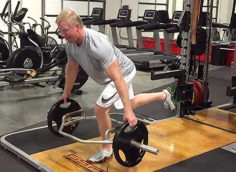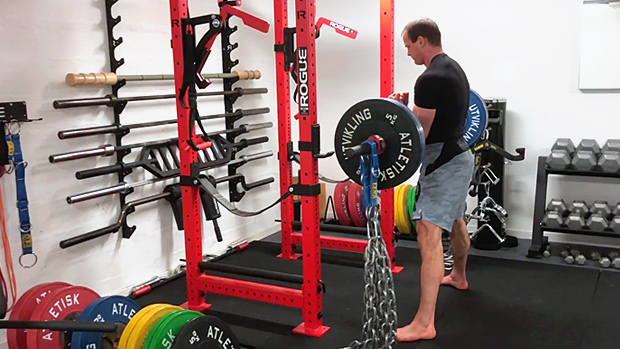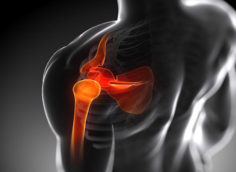Lead Photo Credit: Brandon Campbell
Where Does It Hurt?
Does your lower back hurt during deadlifts, even if you use good form? Do you experience hamstring pain? Have trouble getting below parallel on your squats without your heels popping up? These are signs that your ankle dorsiflexion mobility is a problem.
Ankle dorsiflexion occurs when the angle between the shin (tibia) and the foot gets smaller, either by actively pulling the toes up towards the shin (toes-to-shins) or by leaning the shin forward towards the toes (shins-to-toes). The latter is usually the problem.
Athletes with overall mobility issues and those with a history of previous ankle injuries will often struggle with ankle dorsiflexion, but the pain is only occasionally felt at the Achilles tendon. More often, the Achilles tightness causing the problem will "refer" pain up the kinetic chain to the hams or lumbar spine.
Oddly enough, you may be able to get your heels quite low at the bottom of a calf raise, leading you to think your ankle mobility is just fine, but that's toes-to-shins. Your shins-to-toes mobility is still likely a problem.
Improve ankle dorsiflexion mobility with the toes-elevated split squat. To perform the exercise, set up for a normal rear-foot elevated split squat, but elevate the toes of your front foot.

Ideally, this is done by placing the ball of your foot on a 1x4 (the pieces of wood lifters sometimes use under their heels when squatting). A rolled-up towel or a ten-pound plate will also do the job. Focus on an even "tripod" weight distribution between your heel, the ball of the foot on the big toe side, and the ball of the foot on the pinkie toe side.
Just those few additional degrees of dorsiflexion during split squats, performed regularly, will help improve your ankle mobility and will make a big difference in your squat and deadlift performance.
Programming Notes:
- If you suspect your ankle dorsiflexion is problematic, shoot for 3 sets of 10-15 reps per leg, at least three times per week.
- Stick with bodyweight-only the first few times you try this exercise so you don't overburden your already-tight Achilles.
- After the first week, start adding load with light dumbbells or kettlebells, or an empty bar on your shoulders. The goal is to dynamically stretch your Achilles, not to build up leg strength, so don't overdo it with load. Gradually progress to the load you normally use for your regular split squats, at which point this version should replace regular split squats.
- This exercise can be performed as a part of an active warm-up before squats and deadlifts or at the end of your workout as mobility work.




